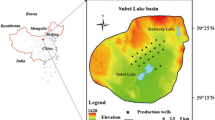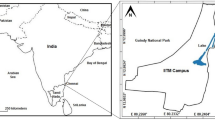Abstract
Determination of wells’ capture zones is one of the most remarkable issues that should be carried out in each aquifer. Methods used for depicting this area has been divided into two simple and complex method. Through the simple one several mathematical equations are used and in the complex approaches, numerical models are applied. In this study, the capture zone of extraction wells in a confined aquifer is determined using random walk algorithm and finite element numerical model. The studied aquifer consists of three extraction wells and one injection well in which the extraction and injection operation are performed for 10,000 days. After the simulation procedure, the groundwater head is obtained. Simulation results show high accuracy which its root mean square error is 0.141 m while this value for finite difference solution is 0.249 m. then the capture zone for each well was depicted individually in two periods of 50 and 180 days. Results showed that the extension of the capture zone for all three wells is toward the part of the aquifer, which has a higher groundwater level than other areas. Also, the results revealed that, in areas of the aquifer that have a higher transmissivity coefficient, the zone is more extended and for the areas with lower transmissivity coefficient, its width decreased and became narrower. In the second well, the width of capture zone in zone 2 and 3 were 302.86 m and 267.46 m, respectively.








Similar content being viewed by others
Explore related subjects
Discover the latest articles and news from researchers in related subjects, suggested using machine learning.References
Akbarpour A, Etebari B, Barzoni S (2011) Groundwater modeling to determine the protection zone of drinking wells (a case study of Birjand). Amirkabir University of Technology, Tehran, Iran
Aliabad FA, Shojaei S (2019) The impact of drought and decline in groundwater levels on the spread of sand dunes in the plain in Iran. Sustain Water Resour Manag 5(2):541–555
Alizadeh A, Afshin S, Danesh S (2013) Determination and zonation of protection zone of mashhad drinking wells. Geogr Res 92:109–127
Ardakani AHH, Shojaei S, Siasar H, Ekhtesasi MR (2020) Heuristic evaluation of groundwater in arid zones using remote sensing and geographic information system. Int J Environ Sci Technol 17(2):633–644
Asadi-Aghbolaghi M, Rakhshanderoo G, Kompani-zare M (2011) Analytical solutions for the capture zone of a pumping well near a stream. Hydrogeol J 19:1161–1168
Badv K, Deriszadeh M (2005) Wellhead protection area delineation using the analytic element method. Water Air Soil Pollut 161:19–54
Barry F, Ophori D, Hoffman J, Canace R (2009) Groundwater flow and capture zone analysis of the Central Passaic River Basin, New Jersey. Environ Geol 56:1593–1603
Bear J (1979) Hydraulics of groundwater. The University of Michigan, McGraw-Hill International Book Co
Cunningham J, Hoelen TP, Hopkins GD, Lebrón CA, Reinhard M (2004) Hydraulics of recirculating well pairs for ground water remediation. Ground Water 42(6):880–889
Delkhahi B, Asadian F (2011) Review of effective factors on drinking wellhead protection area using numerical mathematical model (case study: Yaftabad district, City of Tehran). Iran Water Res J 7(3):89–94
Dong Y, Xu H, Li G (2013) Wellhead protection area delineation using multiple methods: a case study in Beijing. Environ Earth Sci 70:481–488
Duouit J (1863) Estudes Theoriques et Pratiques sur le Mouvement des Eaux. Dunod, Paris
Eslami Z, Shojaei S, Hakimzadeh MA (2017) Exploring prioritized sub-basins in terms of flooding risk using HEC_HMS model in Eskandari catchment, Iran. Spat Inf Res 25(5):677–684
Ferreira JP, Krijgsman B, Feseker T (2004) Models for wellhead protection in regional unconfined aquifers and stratified aquifers. Geofís Int 43(4):651–665
Fienen M, Lou J, Kitanidis P (2005) Semi-analytical homogeneous anisotropic capture. J Hydrol 312:39–50
Goodarzi M, Eslamian SS (2019) Evaluation of WhAEM and MODFLOW models to determine the protection zone of drinking wells. Environ Earth Sci 78:195–203
Grubb S (1993) Analytical model for estimation of steady-state capture zones of pumping wells in confined and unconfined aquifers. Ground Water 31:27–32
Haghani M, Jalalkamali R, Berangi M (2019) Assigning crashes to road segments in developing countries. In: Proceedings of the institution of civil engineers-transport, Thomas Telford Ltd, vol 172, issue 5, pp 299–307
Hemati S, Niksokhan M, Asadiani A (2014) Determining the wellhead protection zone of drinking water wells using numerical model and estimating the effect of harvesting rate (case study: Malik Khalife Plain). Iran Hydra Conf 1–10
Intaraprasong T, Zhan H (2007) Capture zone between two streams. J Hydrol 338:297–307
Javandel I, Tsang C (1986) Capture zone type curves: a tool for aquifer cleanup. Ground Water 24:616–625
Kinzelbach W, Marburgrer M, Chiang W (1992) Determination of groundwater catchment areas in two and three spatial dimensions. J Hydrol 134:221–246
Mansourkhaki A, Berangi M, Haghiri M, Haghani M (2018) A neural network noise prediction model for Tehran urban roads. J Environ Eng Landsc Manag 26(2):88–97
Miller C (2003) A comparison of wellhead protection area delineation methods for public drinking water systems in Whatcom County. Wash J Environ Health 66(2):17–23
Mohtashami A, Akbarpour A, Mollazadeh M (2017) Development of two-dimensional groundwater flow simulation model using meshless method based on MLS approximation function in unconfined aquifer in transient state. J Hydroinformatics 19(5):640–652
Mohtashami A, Hashemi Monfared SA, Azizyan G, Akbarpour A (2019) Determination the capture zone of wells by using meshless local Petrov-Galerkin numerical model in confined aquifer in unsteady state (case study: Birjand Aquifer). Iran J Ecohydrol 6(1):239–255
Mohtashami A, Hashemi Monfared SA, Azizyan G, Akbarpour A (2020) Determination of the optimal location of wells in aquifers with an accurate simulation-optimization model based on the meshless local Petrov-Galerkin. Arab J Geosci 13(1):1–15
Mohtashami A, Hashemi Monfared SA, Azizyan G, Akbarpour A (2021) Estimation of parameters in groundwater modeling by particle filter linked to the meshless local Petrov-Galerkin numerical method. J Hydraul Struct 7(1):16–37
Moinante M, Lobo-Ferreira J (2005) On wellhead protection assessment methods and a case-study application in Montemor-o-Novo, Portugal. In: The fourth inter-celtic colloquium on hydrology and management of water resources, pp 21–34
Pearson K (1905) The problem of the random walk. Nature 72(1867):342–342
Puchalski G (2009) Wellhead protection plan for the city of Barrett. s.l.: Minnesota Department of Health
Rock G, Kupfersberger H (2002) Numerical delineation of transient capture zones. J Hydrol 269:134–149
Sabetraftar A (2013) Guidelines for determining the protection zone of groundwater. Iran’s Ministry of Energy, issue 621
Sadeghi Z, Esmaili K, Kaboli A (2015) Evaluation and comparison of methods for determining the protection zone of wells using a mathematical model (case study of Golestan aquifer). Iran J Irrig Drain 9(2):335–344
Sadeghi-Tabas S, Samadi SZ, Akbarpour A, Pourreza-Bilondi M (2017) Sustainable groundwater modeling using single-and multi-objective optimization algorithms. J Hydroinformatics 19(1):97–114
Samani N, Zarei-Doudeji S (2012) Capture zone of a multi-well system in confined and unconfined wedge-shaped aquifers. Adv Water Resour 39:71–84
Sharief SVM, Eldho TI, Rastgoi AK (2008) Optimal pumping policy for aquifer decontamination by pump and treat method. ISH J Civ Eng 14(2):1–17
Siarkos I, Lationopoulos P (2012) Delineation of wellhead protection zones for the control of point pollution sources in the aquifer of N. Greece. Eur Water 40:3–17
Zarei-Doudeji S, Samani N (2014) Capture zone of a multi-well system in bounded peninsula-shaped aquifers. J Contam Hydrol 164:114–124
Zarei-Doudeji S, Samani N (2016) Capture zone of a multi-well system in bounded rectangular-shaped aquifers: modeling and application. Int J Sci Technol Soc 42(1):191–201
Author information
Authors and Affiliations
Corresponding author
Ethics declarations
Conflict of interest
The authors declare that they have no conflict of interest.
Additional information
Publisher's Note
Springer Nature remains neutral with regard to jurisdictional claims in published maps and institutional affiliations.
Rights and permissions
About this article
Cite this article
Khalilabad, N.M., Mohtashami, A. & Akbarpour, A. Application of random walk algorithm into finite element numerical groundwater model for capture zone depiction. Sustain. Water Resour. Manag. 8, 40 (2022). https://doi.org/10.1007/s40899-022-00618-z
Received:
Accepted:
Published:
DOI: https://doi.org/10.1007/s40899-022-00618-z




